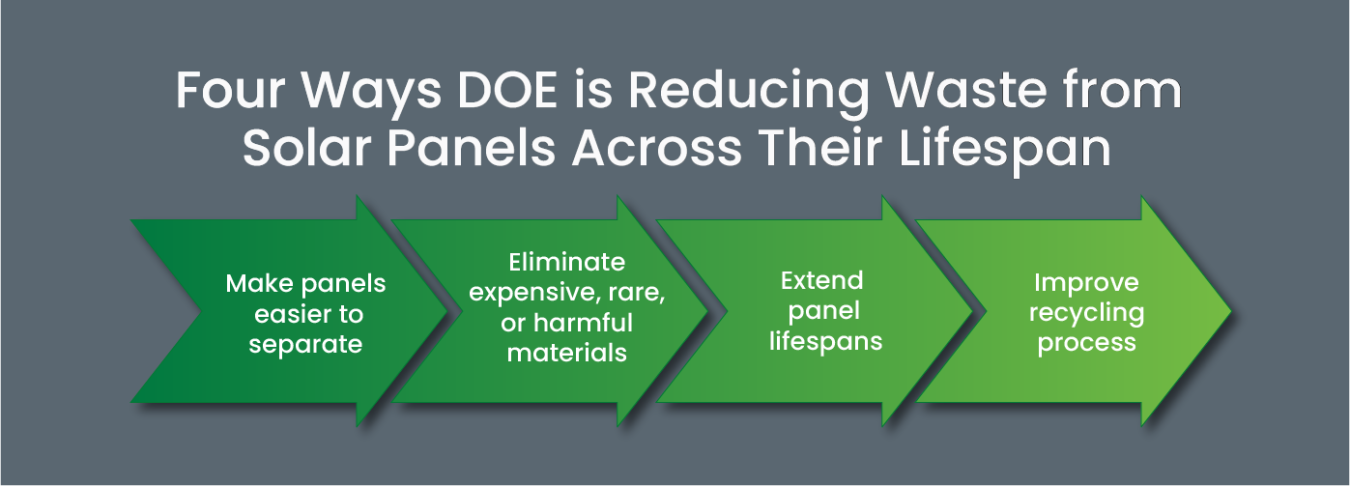
More than 85% percent of a solar photovoltaic (PV) module is made of materials we already know how to recycle, like aluminum and glass. However, solar panel recycling—and most recycling overall—is not currently cost-effective or widely adopted. Making solar module recycling ubiquitous will require a combination of technology and policy innovation. To make a larger impact on reducing waste and other environmental impacts from solar technologies, actions need to be taken before a module is even made.
The U.S. Department of Energy Solar Energy Technologies Office (SETO) is thinking outside the box, innovating the way we design and manufacture panels so they can produce less waste and use more optimal materials. SETO funds research into replacing expensive, rare, or environmentally harmful materials used in solar module production. For example, some SETO projects are working to replace the expensive silver contacts that carry electricity out of a solar cell with copper or aluminum.
Several of our projects are also designing modules with new materials that make them easier to deconstruct. One approach uses sealants that can be dissolved without damaging other panel materials. Another contains layers that allow sections of the panel to be cleanly “unzipped” from others. This ability to easily disassemble solar panels makes reuse, repair, and recycling processes simpler and more efficient. Projects are also investigating ways to reuse waste materials created in the manufacturing process, such as the silicon dust generated by slicing large pieces of silicon into wafers for use in solar cells.
Keeping solar panels in the field longer by making them more durable and easier to repair will also slow and reduce the flow of solar panels into the waste stream. Panels manufactured in the last decade are likely to last 25-35 years, but SETO is working toward 50-year lifespans. An increase in average module lifetime of 2-3 years could decrease waste by 2-3 million metric tons by 2050.
Research to understand and prevent common causes of early breakdowns and power loss, such as damage from extreme weather, can extend solar panel lifespans as well. Developing consistent, industry-wide standards for manufacturing, tracking, and repairing modules will ensure that they last as long as expected, which lowers financial risk and decreases the cost of solar installations.
Then, when PV panels do reach the end of their life, we’re finding more efficient and cost-effective methods to separate all their components for reuse and recycling. SETO released the Photovoltaics End-of-Life Action Plan in 2022, which outlines a five-year strategy to establish safe, responsible, and economic end-of-life practices, and Congress passed $20 million in funding through the Bipartisan Infrastructure Law to help achieve these goals.
For panels that are reaching end of life now, SETO is working to improve material recovery from current recycling processes. Recyclers typically process a panel by removing the frame and grinding up the panel, mixing all the components together. This makes it harder to recover individual materials with high purity. SETO funds research into novel techniques to extract individual materials from this ground-up mix, such as using chemicals that attach to and extract a specific metal, including toxic materials like lead, preventing them from entering landfills. This method would also let us recover rare or expensive materials like indium and silver for reuse.
Most U.S. PV systems are relatively young—about 70% have been installed since 2017. These systems have decades of service left, and SETO is using that time to tackle the technology development needed to make recycling economical. Starting now with a multi-pronged approach will enable the sustainable and carbon-free power system of the future.
Reducing waste from solar panels is one of many approaches that SETO is taking to reduce the environmental impacts of solar energy. We are researching how solar installations interact with wildlife and ecosystems to minimize impacts and maximize benefits, such as providing habitats for pollinators. We’re also finding strategies to protect water and soil health around large solar arrays. By ensuring solar energy is as clean as possible every step of the way, we can use it to sustainably power and protect our planet for generations to come.
Learn more about SETO’s research in photovoltaics and end-of-life management, read the Photovoltaics End-of-Life Action Plan, and learn about the environmental impacts of clean energy.


